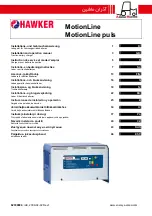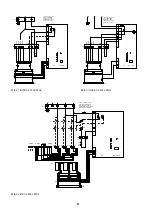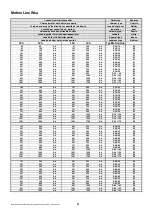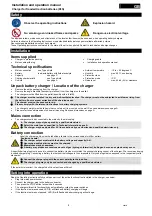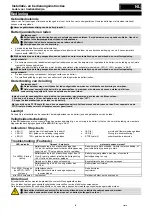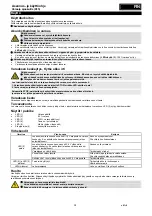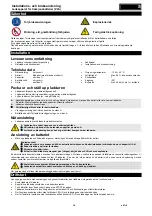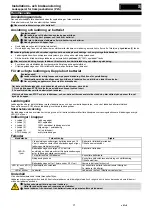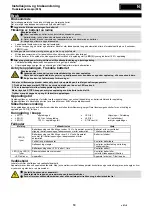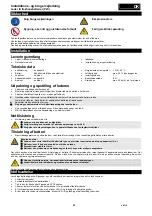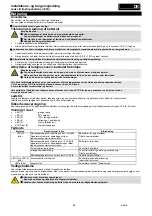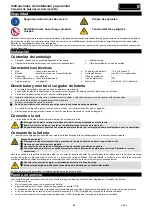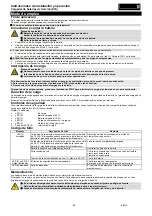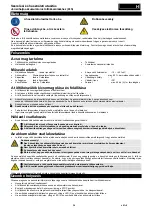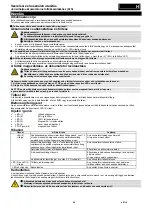
Installation and operation manual
Charger for flooded traction batteries (PzS)
GB
3
v01r0
Operating instructions
Intended purpose
This charger type may only be used to charge vehicle batteries. Closed batteries with non-solid electrolytes can be charged.
z
Please note the operating instructions of the battery!
Connecting and charging the battery
Explosion hazard!
z
Explosive gases can occur during battery charging. Open or remove battery covers and tray lids.
z
Do not smoke near the charger or when handling batteries.
z
Avoid naked flames and sparks.
•
Connect the charger plug to the battery plug.
•
If mains power is present and the battery is connected, the charger will be switched on automatically after a delay of approx. 8 sec. LED (1)
is “ON”.
z
The charging process must be monitored periodically, depending on the utilisation and environmental conditions.
•
The microprocessor in the charger electronics will monitor the charging process and calculate the total charging level in order to terminate
charging at the right time.
•
The charger will be switched off automatically when the battery is fully charged.
LED (3)
“100% charged” will light.
z
If the battery remains connected to the charger after termination of the charging process, the battery will receive maintenance
(hold charging) and equalizing charging.
•
The preservation charge (hold charging) compensates for the own loss of the battery.
•
The equalizing charge provides for a steady load distribution within the battery cells.
Interruption of the charging process, disconnect the battery
Explosion hazard!
z
The charger plug must never be removed during charging so as to avoid electrical sparks. In conjunction with the
ox hydrogen gas which may be produced during charging, this could cause an explosion.
z
If arcing occurs, this could result in burns.
Should it be necessary to interrupt the charging process, proceed as follows:
1.
To interrupt the charging process, press STOP (6);
all LEDs are “OFF”
2. Disconnect the plugs between the charger and the battery.
The charging process can be interrupted, with the battery connected, by pressing the STOP button (6) and can be restarted by
pressing it once more.
Charging time
The charging time is dependent on the ratio of charger current to nominal capacity and on the depth of discharge of the battery being charged.
Safety monitoring
If the charging process cannot be terminated correctly due to a fault in the battery or mains supply, the charging process will be interrupted after
several timeouts. The LED (5) fault will be turned “ON”. (see fault code)
Displays / stop button
•
LED (1)
battery is on charge
•
LED (2)
80% charged
•
LED (3)
100% charging is terminated
•
LED (4)
puls charging
•
LED (5)
fault (see fault code)
•
button STOP (6)
interrupts the charging process
Fault code
Message
Explanation
Remedy (What to do?)
At the start of the charging process the battery voltage is
lower than 1.5 V/cell. Charger waits for the battery
voltage to rise before commencing charging.
Battery too deeply discharged. Do not over-use in future, or
nominal battery voltage too low.
call for service.
At the start of the charging process the battery voltage is
higher than 2.4V/cell. Charger waits for the battery
voltage to fall before commencing charging.
Battery has just been charged. Wait, or battery voltage too
high.
Wrong battery connected to the charger.
Check the battery.
Ready to charge, no mains voltage present
Check mains power and cable or
call for electric maintenance
LED (5)
”ON”
Battery voltage is still lower than 2.0 V/cell after 60
minutes.
Check the battery.
LED (5) and LED (3)
„ON“
Charging time has been exceeded.
Check the battery
or allocation charger to the battery wrong
all LEDs are flashing System fault
The charger is defective, call for service
Maintenance
At servicing works is to be corresponded to the local regulations.
No special maintenance is required for the charger.
Checking and possibly cleaning the charger, depending on the dirt / dust of the environment at the site of use, is required at suitable intervals.
z
The voltages inside the charger are potentially lethal. Only qualified electricians are allowed to open and repair
the charger.
z
Disconnect charger from mains supply and battery before opening!

